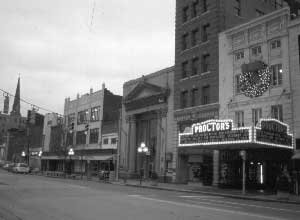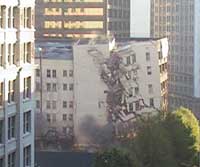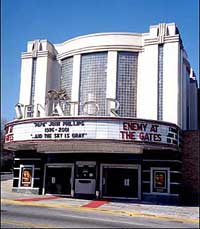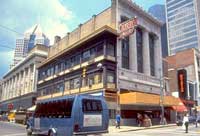|
There Goes the Neighborhood To spark urban renewal, some towns dynamite history. Story by Susanna French
Even before the flood of 1999, the 26 residents of Littleport, Iowa, struggled to keep the town afloat. When the Volga River overflowed, the town had to decide what to do with its ruined two-block downtown. Littleport’s declining population—down 70 percent in 2000—made talk of rebuilding and relocation difficult. What Mayor J.P. Zapf did late last summer put the dying town on the evening news around the world. Advertising Littleport as "the town you can blow up," Zapf offered it on the Internet to any Hollywood studio that needed a small town to dynamite to smithereens for an action movie. "I can’t see any feasible way we can keep the town going," Zapf told the Chicago Tribune on Sept. 9. "If we can do something that’ll cause Littleport to be remembered, that’s good." In the 1960s and 1970s, many historic areas in America’s towns and cities were demolished in the name of urban renewal. When the dust settled and many of those ambitious projects failed, preservation became a new ethic in saving downtowns. But even today, some towns continue to rip out entire blocks, sometimes whole districts, seeking economic renewal. What brings communities to the point of destroying their historic assets? The Hudson River town of Catskill, N.Y., for instance, may be changed forever if plans are carried out to demolish 10 historic buildings for the county’s new offices and a parking lot. Citing the town’s depressed economy, the county reasons that bringing hundreds of office workers downtown will provide the town with an economic boost while consolidating a scattered county administration. Preservationists say the cost to Catskill’s heritage is too high.
"Catskill is one of the more intact historic districts in the state," says Daniel Mackay of the Preservation League of New York State. "In the past, towns have turned their back on Main Street and brought buildings down, only to realize later the errors of their ways. Other towns would kill to have this kind of architecture available to them." Thomas Cole, architect and founder of the Hudson River school of landscape painting, designed one of the doomed buildings in 1841, a former church that is among the last of his surviving structures. Three more buildings may be demolished to create nine parking spaces. Seven of the buildings are part of a National Register historic district, but because the county’s funds are coming from the settlement of a large private tobacco lawsuit, the county is not required to acknowledge any landmark protections the buildings may have. Last year, 11 historic buildings were demolished in nearby Schenectady, a site where ground was broken last month for the state’s Department of Transportation headquarters building. "Right now, it's a huge empty area surrounded by a chainlink fence. It's pretty depressing looking," says Emily Klotz of the Preservation League. "Hopefully something good will be built in its place." But Klotz is optimistic about the new state building, thanks to design guidelines the city recently adopted. "At least they’re trying to make it fit in." Still, she says, eight other buildings may be in jeopardy if the city decides to locate new court offices just across the street.
Georgia State University demolished an entire block in Atlanta's Fairlie-Poplar Historic District for a classroom building, a vision of university president Carl Patton, who wants to integrate the school into the community and revitalize the city’s oldest business district. Preservationists fought the project but found no allies in the city government. The university bought out most of the block’s tenants; those who remained sued but finally settled three years ago after a two–year battle. Construction is under way.
Whole neighborhoods of Pittsburgh and Baltimore were nearly destroyed for redevelopment, landing both cities on the National Trust’s list of America’s 11 Most Endangered Historic Places. In Baltimore, from 75 to 150 historic buildings on the city’s West Side were slated for demolition as part of a redevelopment plan. But last year, the city agreed with local preservationists to make the old buildings part of that plan rather than obstacles in the way of it. "If more cities followed Baltimore’s lead in recognizing that sustainable revitalization means building on the community’s historic character instead of throwing it away, we might not even need an 11 Most Endangered list anymore," said National Trust President Richard Moe.
In Pittsburgh, a large part of the Fifth and Forbes Historic District was nearly razed for a suburban-style retail-entertainment complex. The city’s only arts and crafts-era cast-iron facades and a high concentration of early-20th-century terra-cotta work were in jeopardy. After public pressure and Nordstrom’s withdrawal from the project, Mayor Tom Murphy canceled the plan and instead created incentives for local business owners to rehabilitate their properties and create a marketing plan with the assistance of preservationists. "It’s not necessary to destroy a historic district in order to save it," Moe says. "The very concept represents a misguided approach to redevelopment that was discredited long ago." As for the sad case of Littleport, the appeal of letting Littleport go out with a bang evaporated after Sept. 11. Officials now expect it will be torn down in the near future. |




